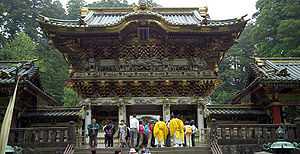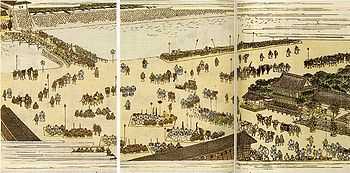Kyōhō Reforms
| History of Japan |
|---|
 Nikkō Tōshō-gū, dedicated to Tokugawa Ieyasu, the founder of the Tokugawa Shogunate. |
The Kyōhō reforms (享保の改革 kyōhō no kaikaku) were an array of economic and cultural policies introduced by the Tokugawa Shogunate in 1736 Japan, during the Edo Period. These reforms were instigated by the eighth Tokugawa shogun of Japan, Tokugawa Yoshimune, encompassing the first twenty years of his shogunate.[1]
Meaning of name
In the name of the Kyōhō Reforms, "Kyōhō" refers to the nengō (Japanese era name) after Shōtoku and before Genbun. In other words, the Kyōhō Reforms occurred during Kyōhō, a period from July 1716 through April 1736[2] within the larger (but not a nengō) Edo period. The reforms overlapped somewhat into the next era, which was proclaimed in the year Kyōhō 21 (1736) on the 21st day of the 4th month to mark the enthronement of Emperor Sakuramachi.
Purpose of the reforms

The reforms were aimed at making the shogunate financially solvent, and to some degree, to improve its political and social security. Because of the tensions between Confucian ideology and the economic reality of Tokugawa Japan (Confucian principles that money was defiling vs. the necessity for a cash economy), Yoshimune found it necessary to shelve certain Confucian principles that were hampering his reform process.
The Kyōhō Reforms included an emphasis on frugality, as well as the formation of merchant guilds that allowed greater control and taxation. The ban on Western books (minus those relating or referring to Christianity) was lifted to encourage the import of Western knowledge and technology.
The alternate attendance (sankin kōtai) rules were relaxed. This policy was quite a burden on daimyo, due to the cost of maintaining two households and moving people and goods between them, while maintaining a show of status and defending their lands when they were absent. The Kyōhō Reforms relieved this burden somewhat in an effort to gain support for the shogunate from the daimyo.
Chronology
The shogunate's interventions were only partly successful. Intervening factors like famine, floods and other disasters exacerbated some of the conditions which the shogun intended to ameliorate.
- 1730 (Kyōhō 15): The Tokugawa shogunate officially recognizes the Dojima Rice Market in Osaka; and bakufu supervisors (nengyoji) are appointed to monitor the market and to collect taxes.[3] The transactions relating to rice exchanges developed into securities exchanges, used primarily for transactions in public securities.[4] The development of improved agriculture production caused the price of rice to fall in mid-Kyōhō.[5]
- August 3, 1730 (Kyōhō 15, 20th day of the 6th month): A fire broke out in Muromachi and 3,790 houses were burnt. Over 30,000 looms in Nishi-jin were destroyed. The bakufu distributed rice.[6]
- 1732 (Kyōhō 17): The Kyōhō famine was the consequence after swarms of locusts devastated crops in agricultural communities around the inland sea.[7]
The following reforms
This reform movement was followed by three others during the Edo period: the Kansei reforms of the 1790s, the Tenpō reforms of the 1830s, and the Keiō reforms of 1866-1867.[8]
Notes
- ↑ Bowman, John Stewart. (2000). Columbia Chronologies of Asian History and Culture, p. 142; Titsingh, Issac. (1834). Annales des empereurs du japon, pp. 416-417.
- ↑ Nussbaum, Louis-Frédéric. (2005). "Kyōhō" Japan Encyclopedia, p. 584, p. 584, at Google Books; n.b., Louis-Frédéric is pseudonym of Louis-Frédéric Nussbaum, see Deutsche Nationalbibliothek Authority File.
- ↑ Adams, Thomas. (1953). Japanese Securities Markets: A Historical Survey, p. 11.
- ↑ Adams, p. 12.
- ↑ Hayami, Akira et al. (2004) The Economic History of Japan: 1600-1990, p. 67.
- ↑ Ponsonby-Fane, Richard. (1956). Kyoto: the Old Capital, 794-1869, p. 320.
- ↑ Hall, John. (1988). The Cambridge History of Japan, p. 456.
- ↑ Traugott, Mark. (1995). Repertoires and Cycles of Collective Action, p. 147.
References
- Adams, Thomas Francis Morton. (1953). Japanese Securities Markets: A Historical Survey, Tokyo: Seihei Okuyama.
- Hall, John Whitney. (1988). The Cambridge History of Japan, v4: "Early Modern Japan." Cambridge: Cambridge University Press. ISBN 0-521-22357-1
- Hayami, Akira, Osamu Saitō, Ronald P Toby. (2004) The Economic History of Japan: 1600-1990. Oxford: Oxford University Press. ISBN 0-19-828905-7
- Ponsonby-Fane, Richard A.B. (1956). Kyoto: the Old Capital, 794-1869. Kyoto: Ponsonby-Fane Memorial.
- Screech, Timon. (2006). Secret Memoirs of the Shoguns: Isaac Titsingh and Japan, 1779-1822. London: RoutledgeCurzon. 10-ISBN 0-7007-1720-X (cloth); 13-ISBN 978-0-7007-1720-0 (cloth); 13-ISBN 978-0-203-09985-8 (electronic)
- Titsingh, Isaac. (1834). [Siyun-sai Rin-siyo/Hayashi Gahō, 1652], Nipon o daï itsi ran; ou, Annales des empereurs du Japon. Paris: Oriental Translation Fund of Great Britain and Ireland.
- Traugott, Mark. (1995). Repertoires and Cycles of Collective Action. Durham, North Carolina: Duke University Press. 10-ISBN 0-822-31527-0/13-ISBN 978-0-822-31527-8; 10-ISBN 0-822-31546-7/13-ISBN 978-0-822-31546-9; OCLC 243809107